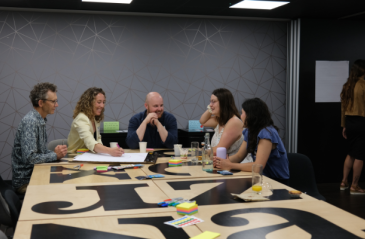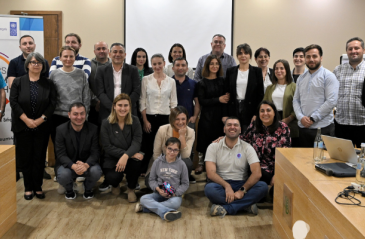
Five things we recently learned about government failure

Healthcare, education standards and safe drinking water among the priorities in Rajasthan
Share articleA new governance model has been constructed to help deliver better outcomes across sectors
Share articleAlthough it remains relatively early days, the initial results in Rajasthan are encouraging
Share articleWe put our vision for government into practice through learning partner projects that align with our values and help reimagine government so that it works for everyone.
"I see a lot of activity but just not enough impact from my government's programmes and schemes," Smt. Vasundhara Raje told us. It was late 2014 and we were meeting in her office in her government's headquarters in the Indian state of Rajasthan. As the state's chief minister - a position she had recently returned to - she had much on her plate. But prime among her many priorities was ensuring that outcomes - citizen outcomes - were on the up.
Unfortunately, her refrain was one that is surely common to politicians the world over. Somehow, the policies they sign off in the Cabinet room struggle to navigate the bureaucratic machinery of government. And even when they do emerge into the light of the real world, their impact often falls short of the original vision. Given that the lifeblood of any government is - or should be - the delivery of results for citizens, Chief Minister Raje's concern was understandable. So, too, was her request for some help.
First, some context. Rajasthan is India's largest state by area. The same size as Germany and with a larger population than England or France, it is situated in the north of the country. But while its rich cultural heritage has long seen tourists flock across its borders, there are other features that aren't as attractive. Affordable healthcare, higher standards of education, and safe drinking water are just a few of the issues to have loomed large in the chief minister's in-tray since her return to office.
Now, it is important to note that the government has hardly stood idle since the chief minister's return to power. Numerous projects and programmes have been unleashed, as well as a significant boost to public spending, all in an attempt to address the state's deep-rooted challenges. Although some progress has been made - much-needed land reforms have been enacted and doing business is now easier - there remains plenty of scope for improvement.
It can be done. From Cape Town to Colombia, the Bahamas to Baltimore, administrations have succeeded in strengthening the delivery of their policies and, as a result, their citizens have benefited. But it's not easy. Improving citizen outcomes requires a nuanced approach, one that reflects the complexity of government but at the same time ensures a level of consistency which makes results the guiding North Star.
So, what did the BCG team do?
Our starting point was to construct a governance model to help deliver better outcomes across sectors. This amounted to ensuring that policymakers were aligned on the vision before moving on to robust implementation planning and monitoring, and then through to assessing the effectiveness of projects in hitting targets. For example, before we did anything else we helped the government define sector-specific goals which were feasible and valued by the community. So for the health sector, this meant affordable and high-quality primary healthcare for all residents, delivered via primary health centres (PHCs), with no citizen further than 10 km away from their nearest PHC. To achieve these goals, the Rajasthan government set a target of relaunching 295 PHCs as “Adarsh PHCs” on 25 August 2016, India's Independence Day.
Once the targets were agreed on, we helped departments develop transformation road maps with clear milestones and timelines, and a programme management unit was set up to monitor overall progress. Indeed, one should not underestimate the importance of metrics. As Melanie Walker, director of the President's Delivery Unit at the World Bank attests, "if you can't measure something, you will struggle to manage it”. Existing systems were strengthened and tracking tools provided to ensure a regular flow of data from the field and to enable the effective measurement of improvements and impact. For instance, in healthcare, the availability of doctors and nurses was a primary driver for patient visits at the health centres; hence, current systems were strengthened to capture staff availability and attendance.
Rigorous monitoring and review was identified as essential for driving accountability across all levels. With this in mind, we also helped design district-level tracking tools (e.g., a mobile app for district officers) and organised video conferences with the health minister to facilitate reviews. A visualisation approach was adopted and dashboards developed to facilitate the chief minister's reviews and to track key actions. Ensuring that the lead politician and key officers can stay abreast of the latest trends and developments is a core principle of the approach in many governments. In Malaysia, for example, progress is mapped at cabinet awaydays and public town halls.
Government systems carry the weight of the entire machinery and bureaucracy, so it is important to recognise and reward good performance. Furthermore, the credit should be shared with the field: e.g., Adarsh PHCs which demonstrated the best practices and most impressive initiatives were congratulated by the health minister in his monthly review.
And finally, we want to make sure that these changes are sustainable. To do so, we have instituted reforms aimed at endowing the government with a greater set of functional capabilities. These include: introducing interactive voice response surveys for citizen feedback; revising the procurement process for better quality and speed; and seeking external help with communication and PR for each key scheme.
Although it remains relatively early days, some key lessons have already crystallised in our thinking. Reiterating priorities is crucial, as is designing "quick wins" to increase momentum and stakeholder buy-in. Accountability measures, too, are of prime importance because data-driven reviews and associated actions ensure faster progress. An administration also needs to dig deep in order to invest in technology and analytics to create a "data-driven" culture.
The chief minister would be the first to admit that there is no one magic bullet that can solve all of society's ills. Nonetheless, the initial results in Rajasthan are encouraging. There has been a 900,000 increase in school enrolment and a 40% increase in patient visits at the focus PHCs, and in six months the government has built nearly 100,000 water conservation structures in 3,500 villages across the state.
Such results offer the reminder - if one were needed - of the sheer power of governments to do good and make a positive difference to the lives of millions of people. This opportunity is one that we and the chief minister fully intend to grasp - watch this space.










